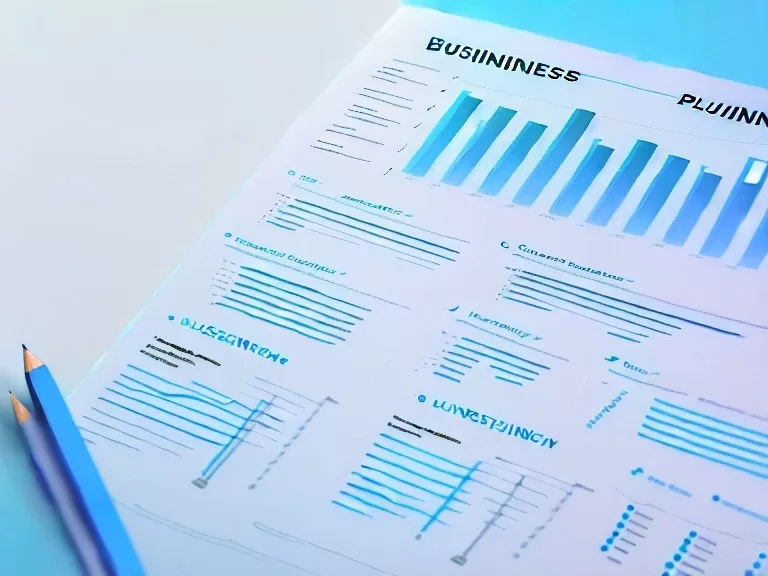Quick One Page Business Plan and How to Create One
April 5, 2023 by Tim Donahue
A one page business plan is a great way to get started
The goal of this article is to help you create a quick one-page business plan that outlines your main objectives and strategies in a clear and concise manner.
We’ll guide you through the essential components of a one-page business plan, offer actionable advice, and provide examples along the way.
>> Scroll down for the downloadable One Page Business Plan template
We’ve provided a great downloadable template that you can use right away – scroll down to download it.
Also check out our huge selection of One Page Business Plans >

1. Describe Your Main Business Objective
Begin by clearly defining your main business objective in one or two sentences. This should be a brief statement that summarizes the primary purpose of your business. For example:
“My business will be designing and selling shoes that help people with foot problems to have less pain and more ability to walk further.”
or
“My business will be online education for people who want to learn to become electricians. We will offer online credentials and proof of knowledge through online tests, videos, and interviews with working electricians.”
2. What Will You Sell Exactly?
Be as specific as possible about the product or service you will be offering. This will help you and potential investors, partners, or customers to understand your business better. Describe your product or service in two or three sentences, such as:
“We will sell custom-designed orthopedic shoes that feature cushioned insoles, arch support, and flexible materials to provide comfort and relief for people with foot pain.”
or
“Our online platform will offer comprehensive courses, practical exercises, and assessments in electrical theory and practice, along with access to a community of experienced electricians for mentorship and guidance.”
3. How Will Your Product/Service Stand Out?
Identify what makes your business unique and how it will stand out from the competition. This may include a unique selling proposition (USP) or a distinctive feature of your product or service. Describe this in two or three sentences, such as:
“Our orthopedic shoes will stand out from competitors because they combine cutting-edge materials with stylish designs, making them both functional and fashionable.”
or
“Our online electrician education platform will stand out from others due to our focus on practical, hands-on learning and direct access to industry professionals for personalized guidance and support.”
4. Perform a Basic Financial Projection
Estimate your potential revenues and expenses to determine whether your business will be profitable. You can use a simple financial forecast spreadsheet to help with this process. Consider the following questions:
- How much money will you need to cover startup costs and monthly expenses for the first year?
- Where will you get the money to launch and build your business? Will you self-fund it, seek loans, or look for investors?
- What are your expected revenue streams, and how will they contribute to your overall profitability?
Downloadable One Page Business Plan Template
Fill it in and refine it as you go. Here’s the Free Downloadable One Page Business Plan Template >>
5. Where Will You Find Your Customers?
Identify the channels and strategies you will use to reach your target audience. This may include:
- Online advertising (e.g., Google Ads, social media ads)
- Content marketing (e.g., blog posts, videos, podcasts)
- Social media engagement
- Email marketing
- Partnerships and collaborations
- Trade shows and events
6. Define Your Target Audience
Determine who your ideal customer is by considering factors such as demographics, buying habits, and values. The more specific you can be, the better you can tailor your marketing efforts to reach them.
For example:
“Our target audience consists of men and women aged 30-60 who suffer from foot pain or discomfort, value quality and style in footwear, and are willing to invest in solutions that improve their quality of life.”
or
“Our target customers are individuals interested in pursuing a career as an electrician, who value flexible learning options and practical, hands-on training. They may be career-changers, recent high school graduates, or professionals seeking continuing education opportunities.”
7. Estimate Market Size
Research your target market to determine its size and potential for growth. You may need to consult industry reports, government data, or other sources to get an accurate estimate. Explain why you believe the market size justifies your business efforts.
8. Identify Your Competition
List your main competitors and analyze their strengths and weaknesses. This will help you understand the competitive landscape and identify opportunities for your business to stand out.
You need to figure out where your business fits within the known competitors.
9. Evaluate Your Competitive Advantage
Explain why you believe your business can compete effectively against your competition. This may involve your unique selling proposition, superior product features, or a more efficient business model.
10. Assess Your Skills and Resources
Consider whether you have the necessary skills to run a successful business, such as communication, marketing, organization, finance, and people management. If you lack certain skills, identify how you can acquire them, whether through self-learning, hiring, or partnering with others.
Finally – Identify the Five Most Important Next Steps
List the top five steps you believe you need to take next to move your business forward. These might include refining your product or service, developing a marketing plan, or seeking funding.
It’s okay if you’re not sure; take your best guess and revise as needed.
What Are Your Next Steps?
Now that you’ve completed your one-page business plan, determine your immediate next steps. This may involve seeking a business mentor, refining your plan, or starting to implement some of the steps you’ve identified.
“I highly recommend you locate a business mentor or two or three who can look at your answers in this Short Format Quick Business Plan to guide you. “
Most likely they will focus on areas that are in need of more attention and will be able to fill you in on what’s coming and give you some good insight based on their experience.
In Summary: The Key Concepts
- Clearly define your main business objective and the product/service you will offer.
- Identify what sets your business apart from competitors and how it will stand out.
- Perform a basic financial projection to estimate profitability and funding needs.
- Understand your target audience and the most effective ways to reach them.
- Assess your skills, resources, and next steps to move your business forward.
Top Tips for a Quick One-Page Business Plan and How to Create One
- Keep it concise: A one-page business plan should focus on the most important aspects of your business, cutting out unnecessary details.
- Be specific: Clearly describe your product or service, target market, and unique selling proposition to help guide your marketing and business decisions.
- Be realistic: Base your financial projections and market size estimates on solid research and data.
- Continually update: A one-page business plan is a living document that should be revisited and updated regularly as your business evolves.
- Seek guidance: Don’t hesitate to consult with mentors or industry experts to gain insights and advice.
What You Can Do To Get Started
- Conduct market research: Learn about your industry, target audience, and competition to better understand the market landscape.
- Develop a prototype or service offering: Before launching your business, create a minimum viable product (MVP) to test the market and gather feedback.
- Create a marketing plan: Identify the most effective channels and strategies to reach your target audience and promote your business.
- Seek funding: Determine your funding needs and explore options such as loans, grants, or equity investments to secure the necessary capital.
- Build a support network: Connect with mentors, advisors, and other entrepreneurs who can provide guidance and support as you build your business.
By following the steps outlined in this guide, you’ll be well on your way to creating a quick one-page business plan that sets the foundation for your business’s success. Remember to keep it concise, specific, and realistic, and be prepared to revise and update it as your business evolves. With a solid plan in place, you’ll be better equipped to navigate the challenges and opportunities that come with launching and growing a successful business.
